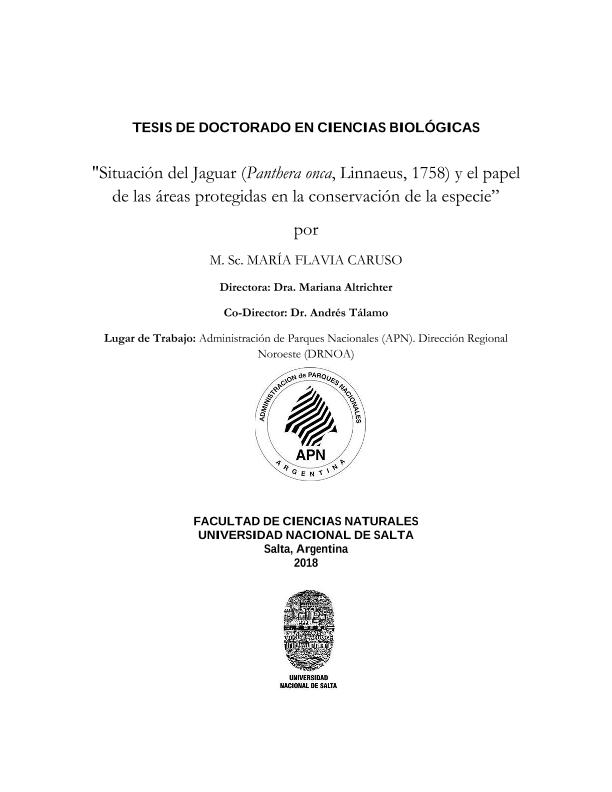Tesis doctoral
El Norte argentino y el Sur de Bolivia albergan la población de jaguar (Panthera onca) más austral en su rango geográfico de distribución y por lo tanto prioritaria para su conservación. Investigué la variación del conocimiento, percepciones y actitudes que los pobladores locales tienen sobre el jaguar y su relación con factores demográficos y socio-económicos, dentro, en la zona de amortiguación y lejos de APs ubicadas en el Norte argentino y Sur de Bolivia. Además, evalué el nivel de conocimiento de los pobladores sobre los beneficios y perjuicios de la existencia del AP de acuerdo a su lugar de residencia (dentro, zona de amortiguación y lejos de las APs). Exploré como influye el tipo de manejo de las áreas protegidas en las actitudes, percepciones y conocimientos de los pobladores locales ante el jaguar y las APs. Las percepciones y actitudes negativas o indiferentes ante la conservación del jaguar entre los entrevistados estuvieron fuertemente relacionadas con tres factores: 1) el bajo nivel de conocimiento que los entrevistados tenían sobre aspectos ecológicos y biológicos de la especie, 2) el miedo casi generalizado con el que el jaguar fue percibido entre los entrevistados independientemente de los factores socio-económicos y 3) la percepción del nivel de impacto económico que causa la depredación de jaguar sobre el ganado doméstico. No encontré relaciones directas entre factores como la edad y los mayores niveles educativos de los encuestados y su apoyo a la conservación del jaguar. El tipo de manejo de las APs puede afectar actitudes y percepciones de los pobladores en relación a las APs, pero no necesariamente hacia el jaguar. Los pobladores vecinos a APs con manejo participativo reconocieron la función y objetivos de las APs pero aun así no identificaron beneficios de la presencia de las AP, y el apoyo sobre su conservación fue similar entre los tipos de manejo. No hubo diferencias entre el tipo de manejo de las APs y las percepciones hacia el jaguar, posiblemente porque aunque el manejo sea participativo el jaguar produce daños económicos y el miedo ante la especie persiste. Para cambiar actitudes y percepciones negativas e indiferentes hacia la especie y ante las APs se necesitan motivaciones y un programa educativo Conocer cómo los pobladores locales dimensionan su entorno ambiental, en particular en áreas rurales donde la conservación de la biodiversidad es de alta prioridad, permitiría planificar nuevas estrategias de manejo y proponer políticas educativas contextualizadas a una realidad local. Northern Argentina and Southern Bolivia are home to the southernmost jaguar (Panthera onca) population and therefore of higth priority for conservation. I evaluated the variation of the knowledge, perceptions and attitudes that the local inhabitants have about the jaguar and its relationship with demographic and socio-economic factors, inside, in the buffer zone and far from PA located in the Northern Argentina and Southern Bolivia. In addition, I assessed the level of knowledge of the residents on the benefits and detriments of the existence of the AP according to their place of residence (inside, buffer zone and far from PAs). I explored how the type of management of protected areas influences the attitudes, perceptions and knowledge of local people toward jaguar and the PAs. The perceptions and attitudes negative or indifferent to the conservation of the jaguar among the interviewees were strongly related to three factors: 1) The low level of knowledge that the respondents had on ecological and biological aspects of the species, 2) the almost generalized fear with which the jaguar was perceived among those interviewed regardless of socio-economic factors and 3), the perception of the level of economic impact caused by jaguar predation on domestic livestock. I did not find direct relationships between factors such as age and the higher educational levels of the respondents and their support for jaguar conservation. The type of management of PAs may affect the attitudes and perceptions of the inhabitants in relation to PAs, but not necessarily to the jaguar. Neighboring residents to PAs with participatory management recognized the function and objectives of APS but still did not identify benefits of PA presence, and support on their conservation was similar among the types of management. There was no difference between the type of management of PAs and perceptions towards the jaguar, possibly because although the management is participatory the jaguar produces economic damage and fear of the species persists. To change attitudes and negative and indifferent perceptions towards the species and the PAs, motivations and an educational program are needed. Knowing how the local population sizes their environmental environment, particularly in rural areas where the conservation of biodiversity is a high priority, would allow planning new management strategies and propose educational policies contextualized to a local reality.
Situación del jaguar (Panthera onca, Linnaeus, 1758) y el papel de las áreas protegidas en la conservación de la especie
Título:
Status of the jaguar (Panthera onca, Linnaeus, 1758) and the management of the protected areas in the conservation of the species
Caruso, María Flavia

Director:
Altrichter, Mariana
Codirector:
Tálamo, Andrés

Fecha de publicación:
09/04/2018
Idioma:
Español
Clasificación temática:
Resumen
Palabras clave:
Argentina
,
Bolivia
,
Conservacion
,
Jaguar
Archivos asociados
Licencia
Identificadores
Colecciones
Tesis(CCT - SALTA-JUJUY)
Tesis de CTRO.CIENTIFICO TECNOL.CONICET - SALTA-JUJUY
Tesis de CTRO.CIENTIFICO TECNOL.CONICET - SALTA-JUJUY
Citación
Caruso, María Flavia; Altrichter, Mariana; Tálamo, Andrés; Situación del jaguar (Panthera onca, Linnaeus, 1758) y el papel de las áreas protegidas en la conservación de la especie; 9-4-2018
Compartir



